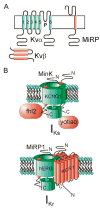Impact of ancillary subunits on ventricular repolarization
- PMID: 17993327
- PMCID: PMC2128763
- DOI: 10.1016/j.jelectrocard.2007.05.021
Impact of ancillary subunits on ventricular repolarization
Abstract
Voltage-gated potassium (Kv) channels generate the outward K(+) ion currents that constitute the primary force in ventricular repolarization. Voltage-gated potassium channels comprise tetramers of pore-forming alpha subunits and, in probably most cases in vivo, ancillary or beta subunits that help define the properties of the Kv current generated. Ancillary subunits can be broadly categorized as cytoplasmic or transmembrane and can modify Kv channel trafficking, conductance, gating, ion selectivity, regulation, and pharmacology. Because of their often profound effects on Kv channel function, studies of the molecular correlates of ventricular repolarization must take into account ancillary subunits as well as alpha subunits. Cytoplasmic ancillary subunits include the Kv beta subunits, which regulate a range of Kv channels and may link channel gating to redox potential, and the KChIPs, which appear most often associated with Kv4 subfamily channels that generate the ventricular I(to) current. Transmembrane ancillary subunits include the MinK-related proteins (MiRPs) encoded by KCNE genes, which modulate members of most Kv alpha subunit subfamilies, and the putative 12-transmembrane domain KCR1 protein, which modulates hERG. In some cases, such as the ventricular I(Ks) channel complex, it is well established that the KCNQ1 alpha subunit must coassemble with the MinK (KCNE1) single-transmembrane domain ancillary subunit for recapitulation of the characteristic, unusually slowly-activating I(Ks) current. In other cases, it is not so clear-cut, and in particular, the roles of the other MiRPs (1-4) in regulating cardiac Kv channels such as KCNQ1 and hERG in vivo are under debate. MiRP1 alters hERG function and pharmacology, and inherited MiRP1 mutations are associated with inherited and acquired arrhythmias, but controversy exists over the native role of MiRP1 in regulating hERG (and therefore ventricular I(Kr)) in vivo. Some ancillary subunits may exhibit varied expression to shape spatial Kv current variation, for example, KChIP2 and the epicardial-endocardial I(to) current density gradient. Indeed, it is likely that most native ventricular Kv channels exhibit temporal and spatial heterogeneity of subunit composition, complicating both modeling of their functional impact on the ventricular action potential and design of specific current-targeted compounds. Here, we discuss current thinking and lines of experimentation aimed at resolving the complexities of the Kv channel complexes that repolarize the human ventricular myocardium.
Figures
Similar articles
-
Does hERG coassemble with a beta subunit? Evidence for roles of MinK and MiRP1.Novartis Found Symp. 2005;266:100-12; discussion 112-7, 155-8. Novartis Found Symp. 2005. PMID: 16050264 Review.
-
The impact of ancillary subunits on small-molecule interactions with voltage-gated potassium channels.Curr Pharm Des. 2006;12(18):2285-302. doi: 10.2174/138161206777585175. Curr Pharm Des. 2006. PMID: 16787255 Review.
-
Targeted deletion of kcne2 impairs ventricular repolarization via disruption of I(K,slow1) and I(to,f).FASEB J. 2008 Oct;22(10):3648-60. doi: 10.1096/fj.08-110171. Epub 2008 Jul 4. FASEB J. 2008. PMID: 18603586 Free PMC article.
-
Regulation of the Kv2.1 potassium channel by MinK and MiRP1.J Membr Biol. 2009 Mar;228(1):1-14. doi: 10.1007/s00232-009-9154-8. Epub 2009 Feb 14. J Membr Biol. 2009. PMID: 19219384 Free PMC article.
-
Accessory Kvbeta1 subunits differentially modulate the functional expression of voltage-gated K+ channels in mouse ventricular myocytes.Circ Res. 2005 Mar 4;96(4):451-8. doi: 10.1161/01.RES.0000156890.25876.63. Epub 2005 Jan 20. Circ Res. 2005. PMID: 15662035
Cited by
-
Weighing the evidence for a ternary protein complex mediating A-type K+ currents in neurons.J Physiol. 2008 Dec 1;586(23):5609-23. doi: 10.1113/jphysiol.2008.161620. Epub 2008 Oct 9. J Physiol. 2008. PMID: 18845608 Free PMC article. Review.
-
Mitochondria and arrhythmias.Free Radic Biol Med. 2014 Jun;71:351-361. doi: 10.1016/j.freeradbiomed.2014.03.033. Epub 2014 Apr 5. Free Radic Biol Med. 2014. PMID: 24713422 Free PMC article. Review.
-
Effect of Maternal Antidepressant Use During the Pre-pregnancy/Early Pregnancy Period on Congenital Heart Disease: A Prospective Cohort Study in Central China.Front Cardiovasc Med. 2022 Jul 5;9:916882. doi: 10.3389/fcvm.2022.916882. eCollection 2022. Front Cardiovasc Med. 2022. PMID: 35865384 Free PMC article.
-
Molecular Pathophysiology of Congenital Long QT Syndrome.Physiol Rev. 2017 Jan;97(1):89-134. doi: 10.1152/physrev.00008.2016. Physiol Rev. 2017. PMID: 27807201 Free PMC article. Review.
-
Novel exon 1 protein-coding regions N-terminally extend human KCNE3 and KCNE4.FASEB J. 2016 Aug;30(8):2959-69. doi: 10.1096/fj.201600467R. Epub 2016 May 9. FASEB J. 2016. PMID: 27162025 Free PMC article.
References
-
- MacKinnon R. Determination of the subunit stoichiometry of a voltage-activated potassium channel. Nature. 1991;350(6315):232–5. - PubMed
-
- MacKinnon R. Potassium channels and the atomic basis of selective ion conduction (Nobel Lecture) Angew Chem Int Ed Engl. 2004;43(33):4265–77. - PubMed
-
- Papazian DM, et al. Alteration of voltage-dependence of Shaker potassium channel by mutations in the S4 sequence. Nature. 1991;349(6307):305–10. - PubMed
-
- Ackerman MJ. The long QT syndrome: ion channel diseases of the heart. Mayo Clin Proc. 1998;73(3):250–69. - PubMed
Publication types
MeSH terms
Substances
Grants and funding
LinkOut - more resources
Full Text Sources


